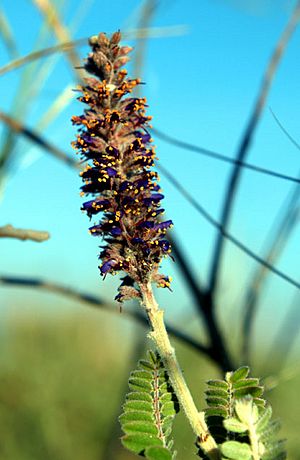Amorpha canescens facts for kids
Quick facts for kids Leadplant |
|
|---|---|
 |
|
| Inflorescence | |
| Scientific classification | |
| Kingdom: | |
| (unranked): | |
| (unranked): | |
| (unranked): | |
| Order: | |
| Family: | |
| Genus: |
Amorpha
|
| Species: |
A. canescens
|
| Binomial name | |
| Amorpha canescens Pursh
|
|
| Synonyms | |
|
|
The Leadplant (Amorpha canescens) is a small plant that grows year after year. It's also known as the downy indigo bush or prairie shoestring. This plant belongs to the pea family, called Fabaceae. You can find it growing naturally in North America.
Leadplant has tiny purple flowers with yellow parts called stamens. These flowers grow together in long clusters. They usually bloom from late June to mid-September, depending on where the plant is. The leaves of the leadplant look a bit grey, which is why it's called "leadplant." This grey color comes from the many tiny hairs on its leaves. Its roots can grow very deep, up to 5 meters (about 16 feet), and spread out about 1 meter (about 3 feet) wide. You can often spot leadplant in dry, well-drained soils in prairies, bluffs, and open woodlands.
Contents
What Leadplant Looks Like
Leadplant usually grows between 0.3 and 1 meter (about 1 to 3 feet) tall. You can easily spot it by its small purple flowers. These flowers are grouped together on long spikes. The plant also has grey-green leaves. These leaves are arranged alternately and are made up of many smaller leaflets.
How it Produces Seeds
After flowering, the leadplant makes small, hairy pods. These pods are a type of legume, and each one holds a single seed inside.
Comparing Leadplant to Similar Plants
Leadplant looks a lot like another plant called Amorpha fruticosa. However, A. canescens is usually shorter, growing only up to 1 meter (about 3 feet) tall. It also prefers drier places to live. In contrast, A. fruticosa can grow much taller, up to 5 or 6 meters (about 16 to 20 feet), and likes wetter areas.
How People Use Leadplant
Leadplant has been used for many different things over time.
Traditional Uses by Indigenous Peoples
Indigenous peoples have used leadplant for its helpful qualities. For example, some tribes believed the plant could help with certain health issues. They used it to treat skin problems like eczema, joint pain like rheumatism, and nerve pain. It was also used on open wounds and cuts. The leaves were often used to make a tea. Dried and crushed leaves were also mixed with buffalo fat for other traditional purposes.
Benefits for Nature and Gardens
Leadplant is very good for the environment. It provides important food for animals that graze, like deer or buffalo. It also helps stop soil from washing away, which is called soil erosion. Because of these benefits, leadplant is sometimes used in landscaping and gardening. It has special roots that contain nitrogen-fixing bacteria. These bacteria help add nitrogen to the soil, which is a nutrient that other plants need to grow well.
About Leadplant's Name
The plant Amorpha canescens was first described by Frederick Pursh in 1814. It belongs to a group of plants called the Papilionoideae, which is part of the larger Fabaceae family (the pea family).
What "Canescens" Means
The second part of its scientific name, "canescens," comes from a botanical Latin term. It means "becoming grey." This name perfectly describes the plant's greyish leaves. Scientists have sometimes tried to divide Amorpha canescens into smaller groups, like A. canescens var. glabrata. These groups were based on how much hair the leaves had or their color. However, these smaller divisions are not usually accepted today. This is because the amount of hair on the plant can vary a lot, even within the same species.
Where to Find Leadplant
You can find Amorpha canescens in many places across North America. Its range stretches from southern Canada down to the northern parts of Mexico. It also spreads east from Montana all the way to Michigan.
Preferred Growing Conditions
Leadplant usually grows in dry prairie and savanna areas. It likes soil that drains well, meaning water doesn't sit around it. It can grow in many different types of soil, including sandy, gravelly, and rocky soils. If you find leadplant growing in an area, it often means that the land is well-cared for. It suggests there hasn't been too much grazing by livestock. It can also mean the land has had regular controlled fires, which help keep the area healthy and prevent it from becoming overgrown.
See also
 In Spanish: Amorpha canescens para niños
In Spanish: Amorpha canescens para niños

